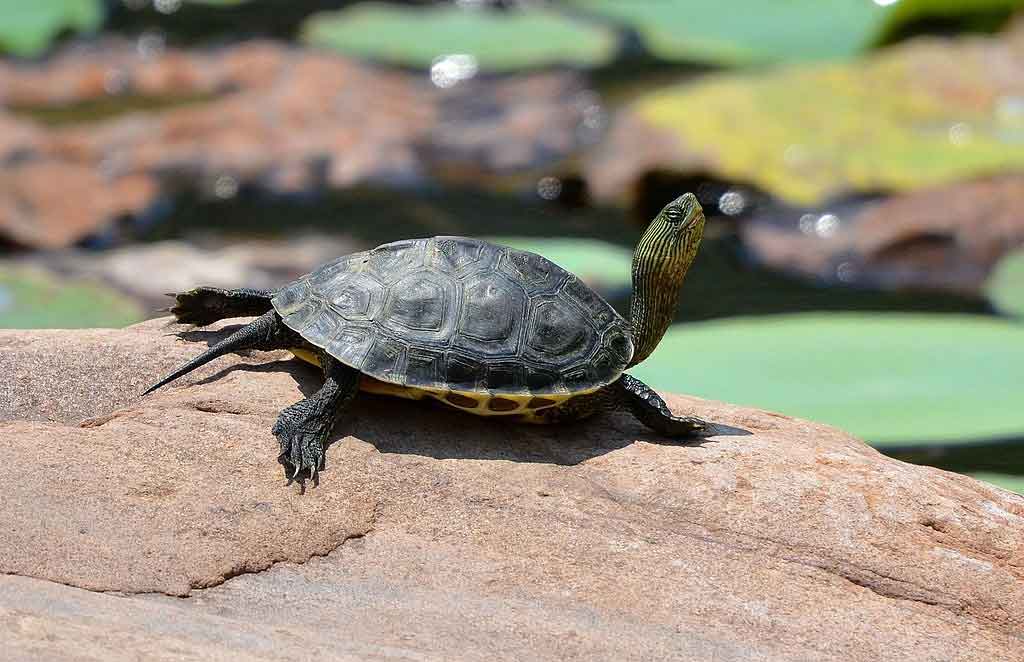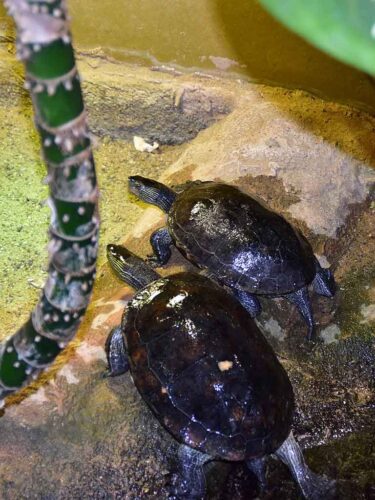
Content |
|---|
Origin / Distribution
The Chinese stripe-necked turtle (Mauremys sinensis) found in the southern coastal provinces of China, north and central vietnam, Laos and Taiwan.
Characteristics / Appearance
The Chinese stripe-necked turtle can reach the 25 cm., for an average of 20 to 22 cm..
The dorsal plate has 3 carinas (1 spinal and 2 side) which are highly visible in young turtles, and fade as the tortoise grows
The back of juveniles is lighter (greenish to light brown, with yellow-orange sprays) than that of adults (Brown very dark). Vertebral scales are wider in front than behind. The 5th vertebral scale is wider than it is long..
The plastron is yellow-orange, with extensive dark spots on each scale.
Compared to other species of aquatic turtles, the tail of the Chinese stripe-necked turtle it is quite long in both males and females.
The head, legs and tail are olive green to gray (more or less dark), with fine light stripes (pale yellow to pale green), which gives it the common name of “striped neck turtle”. The bottom of the head is lighter (yellow).
The iris is cream to pale yellow., with a dark spot.
Sexual dimorphism
The plastron of the male is concave and the tail is longer and thicker than that of the female.. The cloaca is located closer to the tip of the tail., while in females it is found on the supracaudal scales. Males are also smaller than females..
Habitat
This species lives in swamps, muddy canals, slow flowing freshwater streams, ponds, swamps, shallow lakes and muddy ponds. It especially likes bodies of water with lots of vegetation.
Behavior

To the Chinese stripe-necked turtle he likes sunbathing. It is quite a resistant species., peaceful and good swimmer. No hibernation.
Reproduction
Mating takes place mainly in spring. Egg laying takes place just over two months after (about ten eggs on average). The eggs are elliptical in shape and measure 25 x 40 mm. The incubation period can vary from 60 to 150 days.
Newborns measure between 30 and 35 mm.
Food
In the wild, the Chinese stripe-necked turtle feeds both in water and on land: plants and various aquatic plants in large quantities, as well as worms, snails, fish, insects, mollusks, carrion, small crustaceans in smaller quantities. Males and young animals are more likely to feed on meat, while females and older animals are mainly herbivores.
Threats to the species
State of conservation ⓘ |
||
|---|---|---|
 Critical danger ⓘ
(UICN)ⓘ
Critical danger ⓘ
(UICN)ⓘ
| ||
The UICN considers that this species is in danger of extinction in its natural environment (catch for human consumption, urbanization, pollution, etc.).
The "Chinese stripe-necked turtle" in captivity
Aquaterrarium
For one Chinese stripe-necked turtle adult, the aquarium should have a length of at least 120 cm. – 150 cm., since females can grow more than 25 cm.. Of course, juveniles can be kept in smaller tanks and should be if possible. They are relatively good swimmers, but they need many opportunities to climb (plants, estate, stones). The water level should be at least twice the length of the shell.
Even with a water level of 80 cm., the Chinese stripe-necked turtle has no problems and is even more active with a higher water level.
Like all other species of aquatic turtles, the Chinese stripe-necked turtle need clean water. Be prepared to change the water every few days or rely on large external filters (for a 200L aquarium, choose an external filter for a 360L aquarium). We have had the best experience with EHEIM external filters. However, It is advisable to carry out a water change of at least 50% every few weeks.
Sand can be used as a substrate, wash or engrave. If sand is provided, turtles often burrow into it. So, we mainly use sand as a substrate.
To get warm temperatures, the aquarium should also have a heating rod.
In the very hot summer months, the Chinese stripe-necked turtle can be kept in the pond, as long as there are enough plants and other climbing possibilities there too.
Dry ground is absolutely necessary for these sun-loving tortoises. A metal halide lamp (HQI) should also shine above it. In this way, the required ground temperature can be reached without problems, of 40 to 45 °C. As in all species, the female also needs a place to lay her eggs.
The water temperature should be 25-28°C in summer and 20-24°C in spring and autumn. Instead of hibernating, this species goes through the phase of reduced activity, with water at 15°C.
The HQI lamp only shines 6 hours in winter, 8-10 hours in spring and autumn and at least 12 hours in summer.
Keeping them in a group is difficult and only works with females, if it does. But even in this case, individual conservation is always preferable. Males are usually very biting and aggressive as adults..
Food
This species of turtle tends to eat meaty foods, but must have plenty of aquatic plants available. Plant food includes various aquatic plants, like duckweed, mussel flower, duckweed and many more, but also carrots. Fleshy food can consist of live food (worm, mealybugs), but also in frozen food (mosquito larvae, mussel meat, prawns, etc.). Turtle pellets or dry food should only be given occasionally.
Buy one "Chinese stripe-necked turtle"
They can be found in pet stores and some breeders.. The price of the "Chinese stripe-necked turtle" ranges between 30 – 50 EUR.
Videos "Chinese stripe-necked turtle"
|
|
|
|---|
Alternative names:
1. Chinese stripe-necked turtle, Golden thread turtle (English).
2. Emyde à cou rayé, Emyde de Chine (French).
3. Chinesische Streifenschildkröte, Bunte Streifenschildkröte (German).
4. Tartaruga chinesa de pescoço listrado, Tartaruga de fio dourado (Portuguese).
5. Tortuga de hilo dorado, Tortuga de cuello rayado, Tortuga ocadia (español).